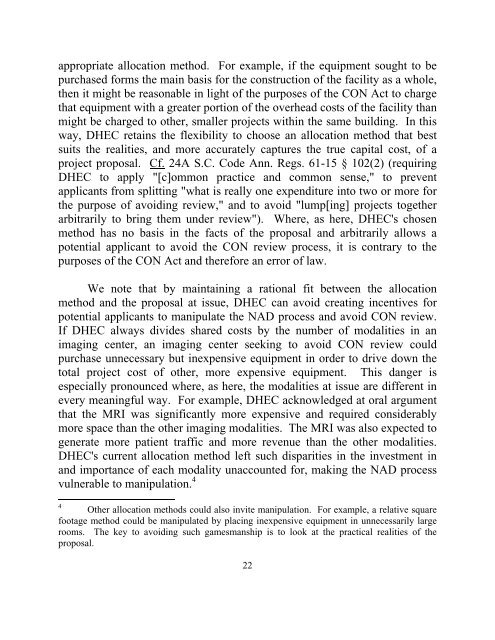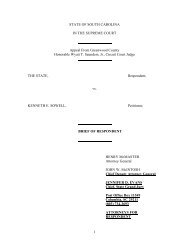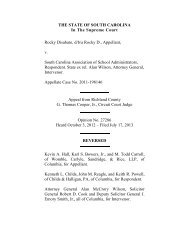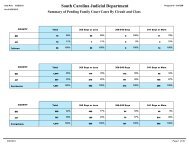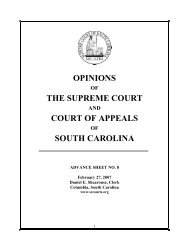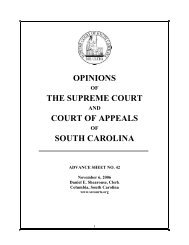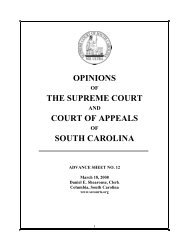The Supreme Court of South Carolina - SC Judicial Department
The Supreme Court of South Carolina - SC Judicial Department
The Supreme Court of South Carolina - SC Judicial Department
Create successful ePaper yourself
Turn your PDF publications into a flip-book with our unique Google optimized e-Paper software.
appropriate allocation method. For example, if the equipment sought to be<br />
purchased forms the main basis for the construction <strong>of</strong> the facility as a whole,<br />
then it might be reasonable in light <strong>of</strong> the purposes <strong>of</strong> the CON Act to charge<br />
that equipment with a greater portion <strong>of</strong> the overhead costs <strong>of</strong> the facility than<br />
might be charged to other, smaller projects within the same building. In this<br />
way, DHEC retains the flexibility to choose an allocation method that best<br />
suits the realities, and more accurately captures the true capital cost, <strong>of</strong> a<br />
project proposal. Cf. 24A S.C. Code Ann. Regs. 61-15 § 102(2) (requiring<br />
DHEC to apply "[c]ommon practice and common sense," to prevent<br />
applicants from splitting "what is really one expenditure into two or more for<br />
the purpose <strong>of</strong> avoiding review," and to avoid "lump[ing] projects together<br />
arbitrarily to bring them under review"). Where, as here, DHEC's chosen<br />
method has no basis in the facts <strong>of</strong> the proposal and arbitrarily allows a<br />
potential applicant to avoid the CON review process, it is contrary to the<br />
purposes <strong>of</strong> the CON Act and therefore an error <strong>of</strong> law.<br />
We note that by maintaining a rational fit between the allocation<br />
method and the proposal at issue, DHEC can avoid creating incentives for<br />
potential applicants to manipulate the NAD process and avoid CON review.<br />
If DHEC always divides shared costs by the number <strong>of</strong> modalities in an<br />
imaging center, an imaging center seeking to avoid CON review could<br />
purchase unnecessary but inexpensive equipment in order to drive down the<br />
total project cost <strong>of</strong> other, more expensive equipment. This danger is<br />
especially pronounced where, as here, the modalities at issue are different in<br />
every meaningful way. For example, DHEC acknowledged at oral argument<br />
that the MRI was significantly more expensive and required considerably<br />
more space than the other imaging modalities. <strong>The</strong> MRI was also expected to<br />
generate more patient traffic and more revenue than the other modalities.<br />
DHEC's current allocation method left such disparities in the investment in<br />
and importance <strong>of</strong> each modality unaccounted for, making the NAD process<br />
vulnerable to manipulation. 4<br />
4<br />
Other allocation methods could also invite manipulation. For example, a relative square<br />
footage method could be manipulated by placing inexpensive equipment in unnecessarily large<br />
rooms. <strong>The</strong> key to avoiding such gamesmanship is to look at the practical realities <strong>of</strong> the<br />
proposal.<br />
22


